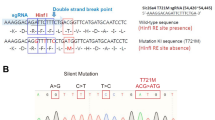Abstract
Otospiralin is a novel protein of unknown function that is produced by non-sensory cells (fibrocytes) of the inner ear (cochlea and vestibule). We showed that downregulation of otospiralin in guinea pigs leads to deafness and we therefore hypothesized that genetic defects in the otospiralin gene could also cause deafness in humans. In this study, we cloned and localized OTOSP, the human gene for otospiralin. OTOSP spans 1,630 nucleotides, contains four exons and codes for a 567-nucleotide cDNA. By fluorescence in situ hybridization and hybrid panel mapping we localized OTOSP on chromosome 2 at position q37.3. There is currently no deafness family linked to this region. We screened OTOSP for mutations in 410 unrelated patients exhibiting various levels of hearing loss. Beside intronic polymorphisms, a rare variant (Pro7Leu) was found in 4 deafness patients and 3 control individuals, indicating that this change is not involved in this condition and excluding OTOSP as a major gene for genetic deafness.


Similar content being viewed by others
References
Marazita ML, Ploughman LM, Rawlings B, Remington E, Arnos KS, Nance WE (1993) Genetic epidemiological studies of early-onset deafness in the U.S. school-age population. Am J Med Genet 46:486–491
Resendes BL, Williamson RE, Morton CC (2001) At the speed of sound: gene discovery in the auditory system. Am J Hum Genet 69:923–935
Petit C, Levilliers J, Hardelin JP (2001) Molecular genetics of hearing loss. Annu Rev Genet 35:589–646
Tekin M, Arnos KS, Pandya A (2001) Advances in hereditary deafness. Lancet 358:1082–1090
Soto-Prior A, Lavigne-Rebillard M, Lenoir M, Ripoll C, Rebillard G, Vago P, Pujol R, Hamel CP (1997) Identification of preferentially expressed cochlear genes by systematic sequencing of a rat cochlea cDNA library. Mol Brain Res 47:1-10
Delprat B, Boulanger A, Wang J, Beaudoin V, Guitton MJ, Venteo S, Dechesne CJ, Pujol R, Lavigne-Rebillard M, Puel JL, Hamel CP (2002) Downregulation of otospiralin, a novel inner ear protein, causes hair cell degeneration and deafness. J Neurosci 22:1718–1725
Spicer SS, Schulte BA (1991) Differentiation of inner ear fibrocytes according to their ion transport related activity. Hear Res 56:53–64
Kelsell DP, Dunlop J, Stevens HP, Lench NJ, Liang JN, Parry G, Mueller RF, Leigh IM (1997) Connexin 26 mutations in hereditary non-syndromic sensorineural deafness. Nature 387:80–83
Grifa A, Wagner CA, D'Ambrosio L, Melchionda S, Bernardi F, Lopez-Bigas N, Rabionet R, Arbones M, Monica MD, Estivill X, Zelante L, Lang F, Gasparini P (1999) Mutations in GJB6 cause nonsyndromic autosomal dominant deafness at DFNA3 locus. Nat Genet 23:16–18
De Kok YJM, Maarel SM van der, Bitner-Glindzicz M, Huber I, Monaco AP, Malcolm S, Pembrey ME, Ropers H-H, Cremers FPM (1995) Association between X-linked mixed deafness and mutations in the POU domain gene POU3F4. Science 267:685–688
Robertson NG, Lu L, Heller S, Merchant SN, Eavey RD, McKenna M, Nadol JB Jr, Miyamoto RT, Linthicum FH Jr, Lubianca Neto JF, Hudspeth AJ, Seidman CE, Morton CC, Seidman JG (1998) Mutations in a novel cochlear gene cause DFNA9, a human nonsyndromic deafness with vestibular dysfunction. Nat Genet 20:299–303
Robertson NG, Resendes BL, Lin JS, Lee C, Aster JC, Adams JC, Morton CC (2000) Inner ear localization of mRNA and products of COCH, mutated in the sensorineural deafness and vestibular disorder, DFNA9. Hum Mol Genet 10:2493–2500
Fransen E, Verstreken M, Verhagen WI, Wuyts FL, Huygen PL, D'Haese P, Robertson NG, Morton CC, McGuirt WT, Smith RJ, Declau F, Heyning PH van de, Camp G van (1999) High prevalence of symptoms of Meniere's disease in three families with a mutation in the COCH gene. Hum Mol Genet 8:1425–1429
Heng HH, Squire J, Tsui LC (1992) High-resolution mapping of mammalian genes by in situ hybridization to free chromatin. Proc Natl Acad Sci U S A 89:9509–9513
Heng HH, Tsui LC (1993) Modes of DAPI banding and simultaneous in situ hybridization. Chromosoma 102:325–332
Miller SA, Dykes DD, Polesky HF (1988) A simple salting out procedure for extracting DNA from human nucleated cells. Nucleic Acids Res 16:1215
Marlhens F, Griffoin J-M, Bareil C, Arnaud B, Claustres M, Hamel CP (1998) Autosomal recessive retinal dystrophy associated with two novel mutations in the RPE65 gene. Eur J Hum Genet 6:527–531
Dryja TP, McGee TL, Hahn LB, Cowley GS, Olsson JE, Reichel E, Sandberg MA, Berson EL (1990) Mutations within the rhodopsin gene in patients with autosomal dominant retinitis pigmentosa. N Engl J Med 323:1302–1307
Acknowledgements
We thank patients and their families for participation in this study. B. Delprat was supported by Caisse d'Epargne and Région Languedoc Roussillon, J.-M. Griffoin and M.-O. Surget were supported by SOS Rétinite France.
Author information
Authors and Affiliations
Corresponding author
Additional information
M. Lavigne-Rebillard and B. Delprat contributed equally to this work.
Rights and permissions
About this article
Cite this article
Lavigne-Rebillard, M., Delprat, B., Surget, MO. et al. Gene structure, chromosomal localization, and mutation screening of the human gene for the inner ear protein otospiralin. Neurogenetics 4, 137–140 (2003). https://doi.org/10.1007/s10048-003-0145-0
Received:
Accepted:
Published:
Issue Date:
DOI: https://doi.org/10.1007/s10048-003-0145-0




